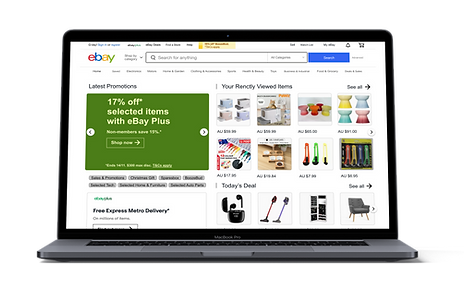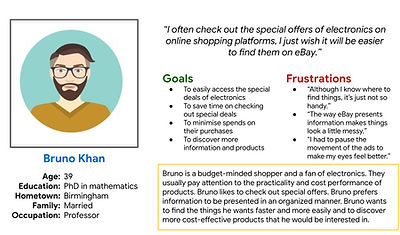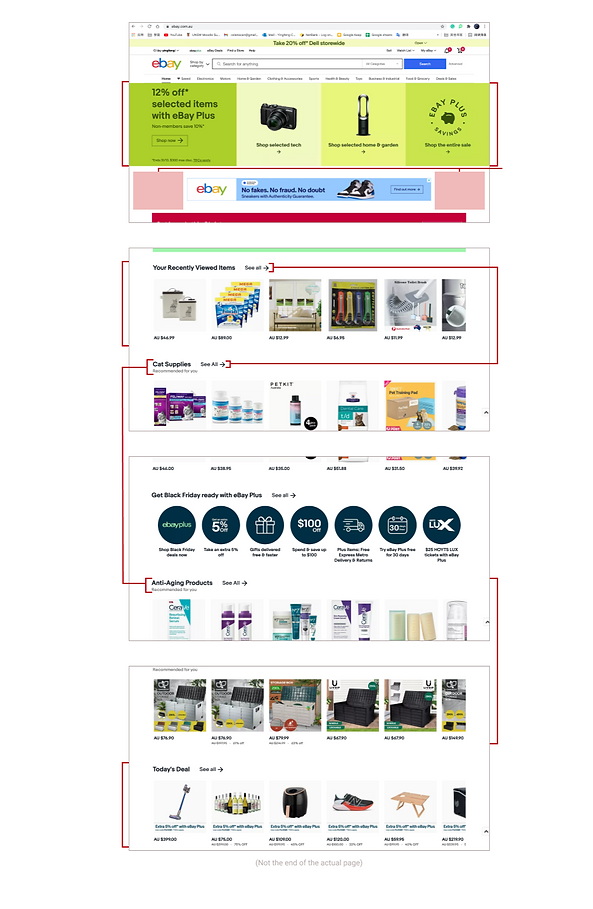

eBay Website Redesign
Re-imagining the homepage to better serve users' shopping needs and make product discovery more enjoyable.
eBay is one of the largest online marketplaces globally, offering a wide variety of products through auctions and direct sales. As a UI/UX Designer, I took on the challenge of reimagining the eBay website experience. The project focused on addressing key pain points in product discovery, information architecture, and user engagement, with the goal of making eBay a more seamless and enjoyable platform for regular shopping.
UX/UI designer
eBay
E-commerce/ Web experience design
Figma | Adobe
MY ROLE AND IMPACT AT EBAY
Research
I initiated the project by conducting research and analysing user feedback to understand the challenges users faced while interacting with website. I gathered data on cart abandonment rates, bounce rates, and conversion rates. Additionally, I reviewed user frustrations via forums and social media, identifying issues like cluttered content, cumbersome navigation, and an outdated interface.
Design
With the insights from research, I sketched low-fidelity concepts and moved into high-fidelity designs, focusing on simplifying the homepage layout, improving information architecture, and enhancing user interactions. I reorganized key content such as personalised recommendations, promotions, and recently viewed items, ensuring that users could easily find the most relevant information.
Testing
I conducted usability tests with multiple regular eBay users to gauge how the new design affected their experience. These tests were crucial in identifying opportunities to refine the design. The feedback from these tests helped me make iterative improvements, such as fine-tuning the positioning of product recommendations and making minor adjustments to the navigation layout.

💭



EBAY
About
Founded in 1995 as Auction Web, eBay has grown into a massive marketplace with over 187 million users. The platform offers a variety of products through both auctions and direct sales. Despite its success, eBay’s website faced several challenges, particularly in delivering a seamless and intuitive user experience.
Challenge
The website's homepage had become cluttered and difficult to navigate. Users struggled to find recently viewed items, personalised recommendations, and deals, often leading to missed opportunities and lower user satisfaction.
User Comments



Discovery & Research
To begin, I needed to deeply understand the user experience issues. I performed an analysis of eBay’s user feedback, focusing on common pain points reported via user forums, eBay’s support tickets, and social media.
I also conducted multiple one-on-one interviews with regular eBay users to uncover frustrations in real-time interactions. These discussions revealed that users wanted a cleaner, more streamlined experience with easier access to recently viewed items and better-targeted product recommendations.

Key Insights
The Interface Prior to Re-design
With the user feedback in mind, I returned to eBay's homepage to pinpoint where the problems were. From there, I defined the problems and began developing solutions.

8
Viewing "Today's Deal" requires a lot of scrolling down, which can cause users to miss it.
6
Users have to view their personalised recommendations by category, which would require more scrolling down to find their categories in mind.
4
Users have to scroll down to find their recently viewed items.
1
The advertising section occupies most space at the top of the page and delivers limited information.
2
The fast slide show of large imagery of ads can make users feel visually uncomfortable.
3
Empty space that can be used to optimise interface design.
5
The microcopies are inconsistent.
7
Each category shows many similar and or identical products. While buyers may find the right seller, they can miss the chance to discover alternative options.
- Challenge -
How might we redesign eBay’s web homepage to improve product discovery, reduce user frustrations, and deliver a more seamless and enjoyable shopping experience? 👀 💭
Solution Features
Informative
Homepage
Each information section takes up less but optimal space to deliver information for users‘ first glance. Top searches and promotions were prioritised and adjusted to avoid visual discomfort.
Browsing
Made-Easy
Simply scroll ◀️ ▶️ to view items of recent interest. Popular searches are listed below the promotions section as buttons, offering a one-click gateway to explore further.
Personalised
Experience
Enjoy browsing all personalised recommendations in one place. Users can scroll through as many recommended items as they like within the section, increasing the chances of finding something of interest.
Validate
After several rounds of testing, the redesigned homepage proved successful in improving user engagement and satisfaction. Users praise the improved layout and easier access to information.
⬆️
User Engagement
-
Improved content accessibility
⬇️
Bounce Rates
-
Find desired content faster
😃
User Satisfaction
-
Easier to naviagte homepage
🌟
Brand Loyalty
-
Users feel 'eBay knows'
Key Learnings
User-Centered Design
In-depth user interviews and testing revealed a gap between my initial assumptions and and the actual needs of users. This discovery prompted me to critically evaluate and improve the design, and continuously gather feedback at key stages, ensuring it aligned closely with user expectations.
Simplification Improves Usability
Streamlining complex interaction flows was essential in improving the overall experience. In this project I learned how simplifying the user journey can significantly enhance usability, making interactions more intuitive and efficient. By decluttering the interface and making actions more straightforward, users can engage with the site in a way that feels more natural and less mentally taxing.
Data-Driven Decisions
Leveraging data to inform decisions is important for creating effective solutions that resonate with users. The combination of qualitative and quantitative data helped shape every stage of the design process and provide a compelling narrative to stakeholders.





